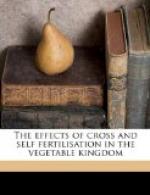In the discussion on the results of a cross with a fresh stock, given under Table 7/C in the last chapter, it was shown that the mere act of crossing by itself does no good; but that the advantages thus derived depend on the plants which are crossed, either consisting of distinct varieties which will almost certainly differ somewhat in constitution, or on the progenitors of the plants which are crossed, though identical in every external character, having been subjected to somewhat different conditions and having thus acquired some slight difference in constitution. All the flowers produced by the same plant have been developed from the same seed; those which expand at the same time have been exposed to exactly the same climatic influences; and the stems have all been nourished by the same roots. Therefore in accordance with the conclusion just referred to, no good ought to result from crossing flowers on the same plant. (8/1. It is, however, possible that the stamens which differ in length or construction in the same flower may produce pollen differing in nature, and in this manner a cross might be made effective between the several flowers on the same plant. Mr. Macnab states in a communication to M. Verlot ‘La Production des Varietes’ 1865 page 42, that seedlings raised from the shorter and longer stamens of rhododendron differ in character; but the shorter stamens apparently are becoming rudimentary, and the seedlings are dwarfs, so that the result may be simply due to a want of fertilising power in the pollen, as in the case of the dwarfed plants of Mirabilis raised by Naudin by the use of too few pollen-grains. Analogous statements have been made with respect to the stamens of Pelargonium. With some of the Melastomaceae, seedlings raised by me from flowers fertilised by pollen from the shorter stamens, certainly differed in appearance from those raised from the longer stamens, with differently coloured anthers; but here, again, there is some reason for believing that the shorter stamens are tending towards abortion. In the very different case of trimorphic heterostyled plants, the two sets of stamens in the same flower have widely different fertilising powers.) In opposition to this conclusion is the fact that a bud is in one sense a distinct individual, and is capable of occasionally or even not rarely assuming new external characters, as well as new constitutional peculiarities. Plants raised from buds which have thus varied may be propagated for a great length of time by grafts, cuttings, etc., and sometimes even by seminal generation. (8/2. I have given numerous cases of such bud-variations in my ’Variation of Animals and Plants under Domestication’ chapter 11 2nd edition volume 1 page 448.) There exist also numerous species in which the flowers on the same plant differ from one another,—as in the sexual organs of monoecious and polygamous plants,—in the structure of the circumferential flowers in many Compositae, Umbelliferae, etc.,—in the structure of the central flower in some plants,—in the two kinds of flowers produced by cleistogene species,—and in several other such cases. These instances clearly prove that the flowers on the same plant have often varied independently of one another in many important respects, such variations having been fixed, like those on distinct plants during the development of species.




